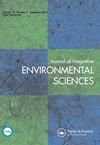农作物秸秆与氮肥结合可减少产量标度的氧化亚氮排放,提高玉米产量和土壤质量
IF 3.5
4区 环境科学与生态学
Q3 ENVIRONMENTAL SCIENCES
Journal of Integrative Environmental Sciences
Pub Date : 2024-02-02
DOI:10.1080/1943815x.2024.2310856
引用次数: 0
摘要
玉米生产需要大量的氮(N)。然而,所使用的氮有很大一部分会以包括一氧化二氮(N2O)在内的反应形式流失到环境中。一氧化二氮的排放和相关的...本文章由计算机程序翻译,如有差异,请以英文原文为准。
Crop residues integration with nitrogen rates reduces yield-scaled nitrous oxide emissions and improves maize yield and soil quality
Maize production requires a large amount of nitrogen (N). However, a greater part of the N used gets lost to the environment as reactive forms including nitrous oxide (N2O). N2O emissions and assoc...
求助全文
通过发布文献求助,成功后即可免费获取论文全文。
去求助
来源期刊

Journal of Integrative Environmental Sciences
ENVIRONMENTAL SCIENCES-
CiteScore
3.90
自引率
0.00%
发文量
13
审稿时长
>12 weeks
期刊介绍:
Journal of Integrative Environmental Sciences (JIES) provides a stimulating, informative and critical forum for intellectual debate on significant environmental issues. It brings together perspectives from a wide range of disciplines and methodologies in both the social and natural sciences in an effort to develop integrative knowledge about the processes responsible for environmental change. The Journal is especially concerned with the relationships between science, society and policy and one of its key aims is to advance understanding of the theory and practice of sustainable development.
 求助内容:
求助内容: 应助结果提醒方式:
应助结果提醒方式:


